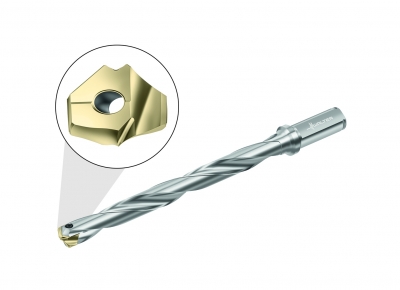
Walter has introduced the P6006 insert for exchangeable-tip drills that brings new levels of drilling efficiency to low carbon steels, structural steels, and low alloy steels. Developed specifically for these unalloyed low-carbon and low-alloy steels, it features optimized geometry, with a sharp cutting edge and deep chip gash that leads to maximum process reliability and efficient chip breakage in low alloy or unalloyed steels. It also offers high centering accuracy, ideal for deep hole drills in the above-mentioned materials.
The P6006 insert can perform up to 10 x Dc without the need for a pilot drill. It features a protective chamfer on the insert with HIPIMS-PVD coating, and the wear resistant WPP25 grade which leads to maximum tool life in stable conditions. Further, the insert has a 100° prism for the contact point in the body, and a 140° point angle with new geometry and thinner web. Optimum wear detection is provided by its light-colored yellow coating. The P6006's current dia. range is 0.472-1.161-in. (12.00–29.50 mm), with plans to increase the diameter range with Walter's next product release. This exchangeable-tip drill finds ready application in general metalworking, and the energy, automotive, and aerospace industries.
The P6006 can be used in all exchangeable-tip drills D4140, D4240, and D4340.
Contact Details
Related Glossary Terms
- alloy steels
alloy steels
Steel containing specified quantities of alloying elements (other than carbon and the commonly accepted amounts of manganese, sulfur and phosphorus) added to cause changes in the metal’s mechanical and/or physical properties. Principal alloying elements are nickel, chromium, molybdenum and silicon. Some grades of alloy steels contain one or more of these elements: vanadium, boron, lead and copper.
- carbon steels
carbon steels
Known as unalloyed steels and plain carbon steels. Contains, in addition to iron and carbon, manganese, phosphorus and sulfur. Characterized as low carbon, medium carbon, high carbon and free machining.
- centering
centering
1. Process of locating the center of a workpiece to be mounted on centers. 2. Process of mounting the workpiece concentric to the machine spindle. See centers.
- metalworking
metalworking
Any manufacturing process in which metal is processed or machined such that the workpiece is given a new shape. Broadly defined, the term includes processes such as design and layout, heat-treating, material handling and inspection.
- point angle
point angle
Included angle at the point of a twist drill or similar tool; for general-purpose tools, the point angle is typically 118°.
- web
web
On a rotating tool, the portion of the tool body that joins the lands. Web is thicker at the shank end, relative to the point end, providing maximum torsional strength.







